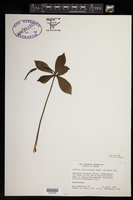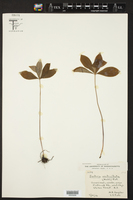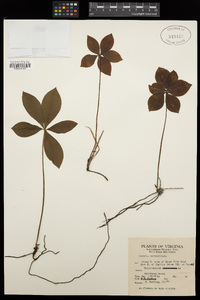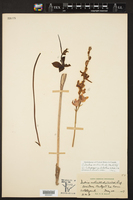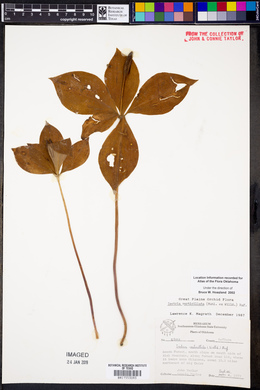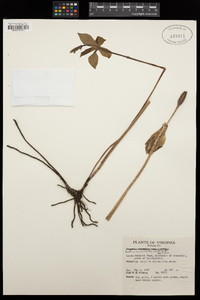Isotria verticillata
|
|
|
|
Family: Orchidaceae
Purple Five-Leaf Orchid, more...large whorled pogonia orchid, large whorled pogonia
[Pogonia verticillata] |
Herbs, clonal, rhizomatous, 4-40 cm. Stems purplish to brownish green, glaucous; scales 2-4, typically below soil line, purplish. Leaves green adaxially; blade oblong-lanceolate, obovate, or elliptic, 25-100 × 10-53 mm, apex obtuse to acuminate, sometimes glaucous abaxially. Flowers pedunculate, showy, sweetly fragrant, without nectar; sepals spreading, purplish brown, narrowly lanceolate, 34-67 × 2-4 mm; petals yellowish green, elliptic-obovate to elliptic-lanceolate, 15-25 × 3-7 mm; lip yellowish green to white, streaked with purple, oblong, 15-25 × 8-9 mm, lateral lobes streaked with purple, margins involute, middle lobe rounded, margins revolute, undulate; callus green, longitudinal, fleshy; column 8-12 mm; ovary 20-30 mm; rostellar flap prominent. Capsules 20-42 × 5-10 mm; pedicel of mature capsule elongating to 20-55 mm. 2n = 18. Flowering Apr--Jun. Acidic soils, in dry to mesic forests, seeps, sphagnum bogs; 10--2000 m; Ont.; Ala., Ark., Conn., Del., Fla., Ga., Ill., Ind., Ky., La., Maine, Md., Mass., Mich., Miss., Mo., N.H., N.J., N.Y., N.C., Ohio, Okla., Pa., R.I., S.C., Tenn., Tex., Vt., Va., W.Va. Isotria verticillata frequently forms extensive clones with hundreds of stems. It is pollinated by solitary bees of the Andrenidae, Anthophoridae, and Halictidae; plants are apparently self-compatible (L. A. Mehrhoff 1983). Nonflowering plants only rarely have a white, arrested floral bud (1-2 mm).
Perennial clonal herb 4 - 40 cm tall Stem: single, erect, hollow, somewhat stout, purplish with grayish coating (glaucous), hairless, with leaves above middle and terminating at flower. Leaves: five to six, whorled, stalkless, green to dark green above, sometimes glaucous below, 2.5 - 10 cm long, 1 - 5.3 cm wide, non-toothed, hairless, somewhat oblong to elliptic or inversely egg-shaped, widest above middle, and usually with somewhat pointed tips. Sepals: three, widely spreading, dark purple, 3.5 - 6.7 cm long (over twice petal length), 1 - 4 mm wide, linear to narrow lance-shaped with narrowed tips. Petals: three, erect, mostly yellowish green, narrow (under 1 cm), with upper two 1.4 - 2.5 cm long, lance-shaped, and positioned together over modified lip petal. The 1 - 2.5 cm long, 0.7 - 1 cm wide, oblong to inversely egg-shaped lip is three-lobed with purplish, oblong, inward rolling lateral lobes, and a yellowish green, rounded central lobe. Terminal lobe of lip with green, fleshy, lengthwise ridge, and whitish, wide, flaring, wavy-edged tip. Fruit: a single, erect, obviously stalked (stalk 2 - 5.5. cm long), ellipsoid, 2 - 4.3 cm long, 0.5 - 1 cm wide, three-angled capsule above withered leaves. Root system: of very long (over 20 cm), clonal spreading rhizomes. Flower: one, terminal, stalked (stalk 2 - 4 cm long), fragrant, showy, dark purple and yellowish green, rather large (over 10 cm wide), bilaterally symmetric with spreading sepals, fairly erect upper petals, and upward-pointed lip, but lacking a spur. The reproductive parts of stamens, stigma and style are fused into a 0.8 - 1.2 cm long column above the 2 - 3 cm long inferior ovary. Similar species: Isotria verticillata is similar to I. medeoloides, but that species is much more rare, has a green stem, pale gray-green leaves, sometimes two flowers, greenish yellow sepals that are barely longer than the petals (under 3 cm), and the capsule stalk is under 1.5 cm long. Another similar orchid is Pogonia ophioglossoides, but it has only one stem leaf, and the sepals are petal-like and deep pink to magenta. When I. verticillata is not blooming it looks very similar to one of its common associates, Medeola virginiana, but that species has a solid, wiry stem with a coating of woolly hairs, and the leaves are more tapered and pointed. Flowering: early May to mid-June Habitat and ecology: Rare, in acid soils, typically moist, second growth woods or more or less poor, sandy soil, but also in shaded, rich bogs. However, Case (1987) indicates that moisture is not important for the species, rather a heavy layer of humus, fairly sterile and acidic soils are required. Occurence in the Chicago region: native Notes: There are only two species in the genus Isotria, and members were previously placed in two other genera, Arethusa or Pogonia. Only a small percent of a population will bloom in any year, but the plants also reproduce asexually by very long rhizomes. Etymology: Isotria comes from the Greek words iso meaning equal, and tria meaning three in reference to the three equal length sepals of the flower. Verticillata means whorled, referring to the leaf arrangement. Author: The Field Museum Colonial; not or scarcely glaucous; stems slender, 2-4 dm; lvs oblong-obovate, 3-5 cm at anthesis, later to 8 cm; peduncle 2-5.5 cm; fls outcrossing, fragrant at first, multicolored, with guide lines; sep projecting forward or somewhat spreading, linear, 3.5-6.5 cm, greenish-brown to purple-brown, more than twice as long as the lateral pet, these 1.5-2.5 cm, yellowish-green, connivent over the column and lip; lip 2-2.5 cm, its lateral lobes purple or strongly purple-veined, the body and the terminal lobe greenish-yellow; 2n=18. Acid soil in woods; s. Me. to Ont. and Mich., s. to n. Fla. and e. Tex. May, June. (Pogonia v.) Gleason, Henry A. & Cronquist, Arthur J. 1991. Manual of vascular plants of northeastern United States and adjacent Canada. lxxv + 910 pp. ©The New York Botanical Garden. All rights reserved. Used by permission. From Flora of Indiana (1940) by Charles C. Deam An inconspicuous plant and apparently very rare and erratic in its distribution. In the lake area it is found in sphagnum in tamarack bogs and south of this area it has been found in white oak woods. …… Indiana Coefficient of Conservatism: C = 7 Wetland Indicator Status: FAC |





